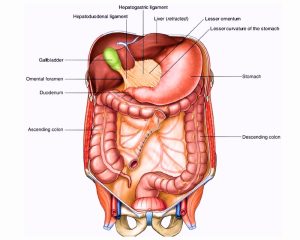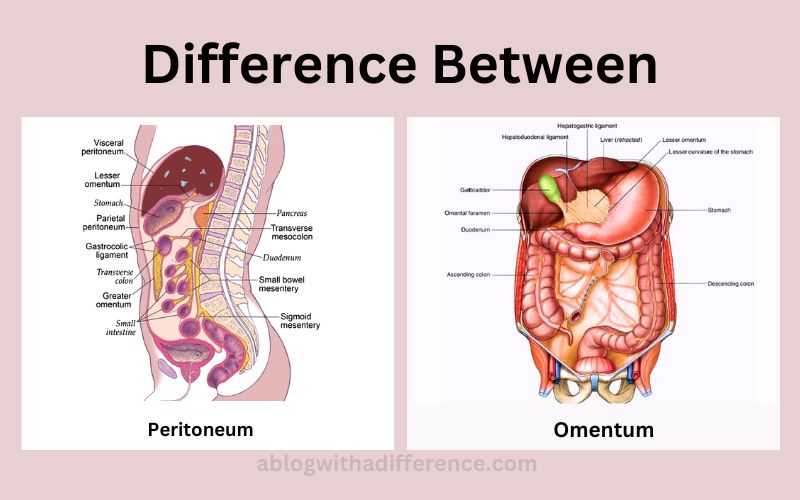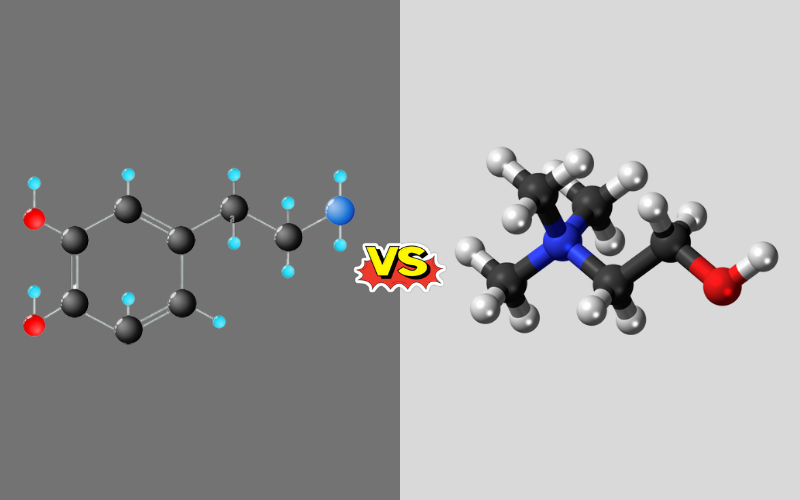Difference Between Peritoneum and Omentum
A brief introduction to Peritoneum and Omentum
Omentum and peritoneum are essential structures in the abdominal cavity that serve distinct roles within our bodies. Understanding their respective roles and clinical significance is paramount. The Peritoneum is a protective membrane that lines the abdominal cavity and protects the organs within. It has two layers – parietal (lining the abdominal wall), and visceral (containing organs). There are various mesentery structures and ligaments supporting and holding organs in place within their membrane lining.
Omentum is two peritoneal folds that extend out from the stomach and hang at the front of intestinal tracts, connecting with each other by two connective tissue rings. There are two varieties of larger (which has more extensive protrusion down), and less extensive omentum that connect the liver and stomach; these hold significant quantities of Adipose tissue which are driven by blood flow.
Although both parts of the same membrane, the peritoneum and omentum differ in terms of location, function, clinical importance, and clinical impact. By exploring these details in greater depth you can gain an in-depth knowledge of what constitutes each organ within the abdomen cavity and their significance to its ecosystem.
Importance of understanding the difference between the peritoneum and omentum
Understanding the difference between the peritoneum and omentum is crucial for several reasons:
1. Treatment and Diagnosis: Differencing the causes of both peritoneal and omental conditions is key for accurate diagnosis and effective treatment planning. Peritonitis, Omental Infarction, Peritoneal Metastasis, and Omental Tumors all feature distinct symptoms and therapeutic strategies, so understanding anatomical/functional differences between Omentum and Peritoneum aids healthcare professionals in making informed decisions for their patient’s well-being.
2. Surgery: Surgeons often encounter both the peritoneum and omentum during various abdominal procedures, so understanding their differences is critical for performing effective surgeries. Proper closure of the peritoneum after surgery is important to prevent complications such as herniation or infections; knowledge of omental anatomy will aid omental resection procedures or flap reconstruction in remaking this area of tissue.
3. Disease Pathology and Spread: Infection, Pathology, and Spread The omentum and peritoneum play key roles in disease processes. The peritoneum can serve as an avenue of inflammation, infection, and metastasis for various cancers; while the involvement of the omental area in tumor growth (particularly stomach and ovarian cancers ). Understanding their distinct features can aid in early disease detection as well as creating effective strategies for treatment.
4. Research and Development: An in-depth knowledge of both the peritoneum and omentum provides a solid base for further research and advancements. Investigating anatomical and molecular variations could yield important discoveries regarding disease causes, targeted treatments, or improved surgical methods; in turn, this knowledge fosters creativity as well as collaboration among healthcare providers, researchers, and academics.
Understanding the differences between Omentum and Peritoneum is critical to accurate diagnosis, treatment, or surgical procedure. It enables healthcare providers to accurately identify causes for diseases while understanding their process of spreading; also aiding advances in knowledge within medicine – this knowledge is beneficial to both healthcare professionals and patients as it improves clinical care while increasing treatments available to patients.
What exactly is Peritoneum?
The peritoneum is part of the abdominopelvic space in the viscera, located between abdominal organs. It provides support and protection to most abdominal organs as well as is used by blood vessels, nerves, and veins to reach other parts of the body.

The peritoneum membrane is a beautiful serous surface with shimmering, clear waters. The peritoneum contains two main layers: parietal and visceral peritoneum. The parietal pertoneum receives blood from both the circulatory system as well as lymph drainage systems. It receives supply by somatic nerves to its supply line supplying nerves of this membrane.
Peritoneal walls are resilient against heat, pressure, and pain while the visceral peritoneum receives impulses from its visceral nerve supply and doesn’t react to temperature, cold, heat, or laceration; however, it does respond to chemical stimuli and stretching.
What exactly is Omentum?
Omentums are double-layered extensions of the peritoneum that look like fold-like structures in your stomach. Omenta can stretch across both stomach and duodenum regions before splitting structurally into greater and lower sections – known respectively as greater and lower Omentas.
The greater omentum refers to prominent folds within the stomach that is curvier, larger in size, fat-filled, and prevent the visceral peritoneum from bonding to the parietal peritoneum. Furthermore, they connect larger curvatures of the stomach with the duodenum.
Peristalsis creates significant movement of the omentum, while its greater portion plays an essential role in protecting against appendicitis by providing a protective shield around an inflamed appendix and its potential harm to surrounding tissues.

Duodenums with smaller curvatures and sizes connect the curvatures of the stomach to its proximal region, and its Omentum has the capacity to release adipokines such as Omentin which act as biomarkers of metabolic syndrome and obesity.
Difference Between Peritoneum and Omentum
A. Peritoneum
The peritoneum is a serous layer that lines the abdominal cavity and covers organs within it. It consists of two distinct layers – parietal and visceral.
1. Parietal Peritoneum:
Location and covering: The parietal line peritoneum lines the inside of your abdominal walls, enclosing both pelvic and abdominal cavities.
Structure: Mesothelium is an extremely thin and transparent layer made up of flat cells supported by connective tissues that cover most of its surface area.
Function: The parietal organ serves two important purposes; protecting structures beneath and providing support to organs within the abdominal cavity.
2. Visceral Peritoneum:
Location and covering: The visceral peritoneum provides protection for abdominal organs like the stomach, liver, spleen, and intestines within their respective cavities.
Structure: Mesothelium that is thinly covered is supported by connective tissues, providing its structure.
Function: Visceral peritoneum provides an oiled, smooth surface that enables organs to move more freely within the abdominal cavity.
B. Omentum
Omentum refers to a folded peritoneum that protrudes from your stomach to cover abdominal organs. There are two varieties of Omentum: greater and smaller ones.
1. Greater Omentum:
Attachment and Location: The Greater Omentum is the larger and more mobile portion of an omentum, attached to its more curvature of the stomach. It drapes across the small intestinal tract.
Structure: It consists of two layers of the peritoneum separated by fatty tissue that create an apron-shaped, lacy structure.
Function: The superior Omentum performs various important functions, such as insulating and protecting abdominal organs, storing fat deposits, as well as form adhesions that protect against infections and prevent their spread.
2. Lesser Omentum:
Attachment and Location: The lesser omentum connects the lesser curvature of the stomach to the liver as well as the beginning of the duodenum to form part of its attachment system.
Structure: It comprises two layers within the peritoneum that house nerves, blood vessels, and lymphatics.
Function: The lower Omentum serves to support both the duodenum and stomach by facilitating blood vessel traffic as well as structures that connect these organs to one another as well as to the liver.
Knowing the structure and anatomy of both the peritoneum and omentum is crucial in order to grasp their roles, functions, and clinical significance in relation to human biology.
Comparison Chart of Peritoneum and Omentum
Here’s a chart that highlights the major differences between the peritoneum as well as the omentum:
| Features | Peritoneum | Omentum |
|---|---|---|
| Location | Lines the abdominal cavity, and protects organs | Extends from the stomach, and protects organs |
| Layers | The parietal and visceral components are present. the peritoneum | It is composed of a double layer of peritoneum |
| Structure | The transparent, thin membrane | Structure that folds and is apron-like |
| Functions | Protection, lubrication, and support | Fat storage and immune modulation, wound healing |
| Blood Supply | The peritoneum is where blood vessels flow through the peritoneum | Rich vascular network |
| Clinical Relevance | Peritonitis, peritoneal dialysis, peritoneal metastasis | Omental tumors, omental infarction, cancer spread |
| Surgical Options | Peritoneal closure and laparoscopic access | Omental flap, omental resection procedures |
Similarities Between Peritoneum and Omentum
While the peritoneum and omentum have distinct roles and characteristics.
There are some similarities between them:
1. Serous Membranes: The peritoneum and Omentum are composed of serous membranes. Composed of the mesothelium that’s supported by connective tissues, serous membranes produce serous fluids to provide fluidity within the abdominal cavity for organ movement. This allows the production of serous fluids which provide fluidity as well as fluidity for fluid transport within organ systems.
2. Double-layered Structure: Both the Peritoneum and Omentum have a two layered structure consisting of an outer layer (parietal peritoneum) covering abdominal organs, and an inner one (visceral peritoneum).
3. Origin and Development: The peritoneum and omentum both develop embryologically from one tissue known as the mesentery, which eventually divides into separate structures including both the peritoneum and omentum.
4. Vascularization: Both the peritoneum and omentum contain extensive networks of blood vessels that supply them with nourishment and oxygen for the proper functioning of both structures. Blood vessels supply vital resources like nutrients and oxygen which support their functionality.
5. Inflammatory Response: Both the peritoneum and Omentum play an integral part in providing immunity in the abdomen cavity. They house immune cells like lymphocytes and macrophages which work together to detect abnormal or Pathogenic cells and eliminate them as quickly as possible.
Even though similarities do exist between them, it is essential to bear in mind that each structure – omentum and peritoneum – has unique anatomical locations and structures as well as functions and clinical significance. Therefore, an understanding of both bodies in the abdomen cavity is vital.
Functions and Roles
A. Peritoneum
1. Protective Function:
- The peritoneum protects organs within its cavities from injury and infections coming from outside, helping keep its environment free of dangers such as injuries and infections from germs or environmental pollutants.
2. Purpose of Lubrication and Facilitation of Movement:
- Serous fluid produced by the peritoneum acts to lubricate abdominal organs, enabling them to work smoothly during biological processes such as breathing and digestion.
3. Lymphatic Drainage and Blood Supply System:
- The peritoneum plays an essential role in blood circulation and lymphatic drainage from abdominal organs. Lymphatic vessels and blood vessels pass through it, carrying oxygen, nutrients, immune cells, as well as waste products away.
4. Its Role in Immune Response:
- The peritoneum is home to numerous immune cells such as lymphocytes and macrophages that play an essential role in identifying and eliminating abnormal or pathogenic cells from within its borders. They play an integral part in local responses against infections as well as contributing to overall abdominal cavity immune surveillance.
B. Omentum
1. Insulin and Fat Storage:
- The Omentum contains an adipose (fat) tissue that acts as an energy reserve storage area. In addition, its protective and cushioning qualities help insulate and cushion abdominal organs while providing warmth and protection.
2. Immune System Modulation:
- The omentum is an integral component in regulating immunity within the abdomen. It hosts numerous immune cells which release various cytokines and growth factors to maintain localized immune regulation while repairing damaged tissues.
3. Wound Healing and Tissue Repair in Healthcare Settings:
- Omentum has remarkable regenerative capabilities and is known for providing much-needed assistance to areas experiencing inflammation or tissue injury. Blood vessels may supply this area as well as assist in healing wounds and tissue repair processes due to their angiogenic and regenerative qualities.
4. Contribution to Adhesion Formation:
- Injuries or inflammation may cause the omentum to attach itself to organs nearby or tissues that have been damaged, creating adhesions that help contain an infection or protect damaged areas but can result in complications like constricted bowels or pain.
Understanding the roles and functions of the omentum and peritoneum helps us gain a greater appreciation of their importance in maintaining abdominal homeostasis immune responses, and tissue repair processes, as well as in providing us with insight into their involvement with various clinical conditions and ailments.
Clinical Significance
A. Peritoneum
1. Sources of Peritonitis:
- Peritonitis occurs when the peritoneum becomes infected and inflamed due to fungal, bacterial, perforated digestive organs or ruptured appendicitis infections, leading to infection of its inner layer, known as periton. Treatment options available to you could include antibiotics as well as surgical intervention – so seek medical assistance immediately!
2. Dialysis of the Peritoneal System:
- The Peritoneum plays an essential part in peritoneal dialysis an effective treatment option for people suffering from kidney failure. When performed by means of dialysis solution injected directly into its cavity through an instrument and eliminated fluid waste as necessary; understanding its anatomy as well as function is key to the successful outcome of dialysis procedures in this region.
3. Peritoneal Metastasis:
- Certain cancers such as Stomach ovarian or pancreatic may spread to the peritoneum and cause metastasis making peritoneal metastasis one of the primary sites for cancer spread within abdominal cavities. Recognizing peritoneal involvement can assist in staging stage identification, prognosis evaluation, and developing an appropriate treatment strategy.
B. Omentum
1. Role of Spread of Certain Cancers:
- The omentum can serve as an important location for metastasis from various cancers, such as colorectal, ovarian, or gastric cancers, to spread. Cancer cells could travel to this organ creating tumors and contributing to its disease development. Understanding its role during cancer spread is vital in creating the optimal staging and treatment plan.
2. Omental Infarction:
- Omental infarction occurs when blood flows through the Omentum and becomes impaired leading to tissue death and death of organs such as the Omentum itself. This could be caused by twisting or torsion of blood vessels within it; symptoms typically manifest themselves with sudden abdominal pain that requires a medical examination and occasionally surgical intervention.
3. Omental Cysts and Tumors:
- Omental cysts and tumors may occur at any age. Omental cysts could be acquired or congenital; tumors could be malignant or benign. Understanding their significance helps in diagnosing and treating them correctly.
Knowledge of the importance of both the peritoneum and omentum are integral to effectively diagnosing and treating various diseases, such as infections cancer metastasis, or cardiovascular emergencies. Understanding their roles and seeking appropriate treatments for them will improve patient outcomes while aiding treatment decision-making.
Surgical Considerations
A. Peritoneum
1. Peritoneal Closure Techniques:
- Closing the peritoneum correctly during abdominal surgery can be critical in avoiding complications like adhesions, hernias or infections. Surgeons employ various techniques such as suturing, stapling or special closure devices to ensure safe and efficient peritoneum closure.
2. Peritoneal Access for Laparoscopic Surgery:
- Laparoscopic procedures involve opening the abdominal cavity through small incisions. Understanding the anatomy and landmarks of peritoneum is vital in providing safe access for trocar placement; surgeons must traverse all layers of peritoneum without damaging tissues or organs during these procedures.
B. Omentum
1. Omental Resection Procedures:
- In rare instances of omental tumors, Omental Resection may be necessary. Removing the Omentum surgically is a meticulous process requiring careful dissection and the ligation of blood vessels in order to stop bleeding; knowing its anatomy, vascularity, and anatomy for safe removal.
2. Omental Flaps in Reconstructive Surgery:
- Omental flaps have long been revered for their regenerative and vascular capabilities, making them invaluable in reconstructive procedures. Omental flaps create vascularized tissue to aid wound healing or cover exposed structures or organs – however to be successful surgeons need an in-depth knowledge of omentum anatomy and blood supply in order to perform these effective Omental flap procedures.
Surgery considerations regarding the omentum and peritoneum reveal the significance of both anatomy knowledge and technical know-how for successful outcomes in abdominal surgeries. Surgeons must be knowledgeable of both closure techniques as well as possible surgical applications of both structures in order to guarantee safe and successful outcomes during abdominal operations.
Conclusion
Understanding the difference between an Omentum and Peritoneum is vital in all aspects of medicine. A peritoneum lines the abdominal cavity, protecting organs that reside there while providing protection, lubrication, and support services.
An omentum extends beyond the stomach to provide additional protection for abdominal organs while helping store fat reserves as well as modulate immunity, wound healing, and repair processes.
Understanding the functions and roles of both the omentum and peritoneum are vital for proper diagnostics, treatment planning, and surgical considerations. Peritoneal dialysis has become an invaluable therapy option in treating peritonitis symptoms; while its presence has also proven useful in managing metastases.


